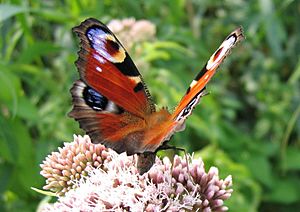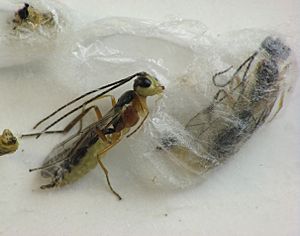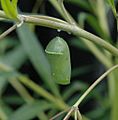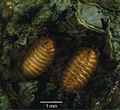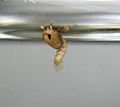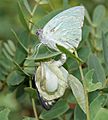Pupa facts for kids
A pupa (say: PYOO-pah) is a special stage in the life cycle of some insects, like butterflies, moths, beetles, flies, and bees. It's when an insect changes from a larva (like a caterpillar) into an adult insect. Think of it as a resting stage where amazing changes happen inside!
The pupa stage of a butterfly is called a chrysalis (say: KRIS-uh-liss). These are often seen hanging out in the open, which makes them a famous example of a pupa.
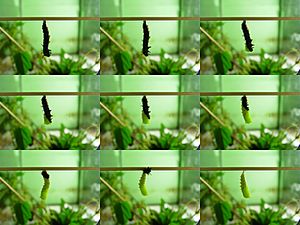
Contents
The Insect Life Cycle
The pupa stage comes right after the larva stage and before the insect becomes a full adult. During this time, the pupa usually doesn't move much or eat. Inside, the insect's body is completely changing. The parts it needs as an adult are forming, while the larval parts are breaking down.
How Long Does Pupation Last?
The pupa stage can last for different amounts of time. It might be a few weeks, several months, or even years! This depends on the temperature and the type of insect. For example, a Monarch butterfly pupa usually lasts about eight to fifteen days.
Sometimes, pupae go into a deep sleep, called dormancy or diapause. They stay this way until the weather is just right for them to come out as adults. In colder places, pupae often sleep through winter. In warmer, tropical areas, they might sleep through the dry season.
How Insects Emerge from the Pupa
When an insect is ready, it "emerges" or "ecloses" from its pupal case. This means it splits open the pupa and crawls out. Most butterflies emerge in the morning. Mosquitoes, however, usually come out in the evening or at night.
Fleas wait for vibrations that tell them a host (like an animal) is nearby before they emerge. After the adult insect comes out, the empty pupal skin is called an exuvia.
Types of Pupae
Scientists classify pupae into different types based on their features.
- Decticous pupa: These pupae have working jaws (mandibles) that they use to chew their way out of a cocoon or pupal case. Examples include some types of Neuroptera and Mecoptera.
- Adecticous pupa: These pupae do not have working jaws. Most beetles, flies, and bees have this type of pupa.
Pupae are also classified by whether their legs and wings are free or stuck to their body:
- Exarate pupa: The legs, wings, and other parts are free and not stuck to the body. They are usually not inside a cocoon. Many beetles and flies have exarate pupae.
- Obtect pupa: The legs, wings, and other parts are stuck closely to the body. These are often found inside a cocoon. Most butterflies and many moths have obtect pupae.
- Coarctate pupa: This type of pupa is hidden inside the hardened skin of the last larval stage, which is called a puparium. The pupa itself is an exarate adecticous type. Many flies have coarctate pupae.
Chrysalis
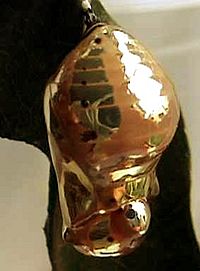
A chrysalis is the pupa stage of a butterfly. The name comes from the Greek word for gold, chrysós, because many butterfly pupae have a shiny, golden color.
When a caterpillar is fully grown, it spins a small silk pad. It then attaches itself to this pad, usually on a leaf or a twig. After this, the caterpillar's skin sheds one last time. Underneath this old skin is the hard, new skin of the chrysalis.
Chrysalises are often colorful and hang out in the open, which is why they are the most well-known type of pupa. Most chrysalises hang upside down, attached by a special hook at their rear end to the silk pad the caterpillar spun.
Like other pupae, a chrysalis usually doesn't move much. However, some butterfly pupae can wiggle their body parts to make sounds or scare away animals that might want to eat them. Inside the chrysalis, the caterpillar's body completely changes into an adult butterfly.
When it's time to emerge, the butterfly uses a special liquid to soften the chrysalis shell. It also has two sharp claws on its front wings to help it break out. After emerging, the butterfly usually rests on the empty chrysalis shell to let its wings expand and harden. If the chrysalis fell to the ground, the butterfly would find another vertical surface, like a wall or fence, to rest on.
Moth pupae are usually dark and are often found underground, in the soil, or inside a protective silk case called a cocoon.
It's easy to get pupa, chrysalis, and cocoon mixed up!
- A pupa is the insect stage between the larva and the adult.
- A chrysalis is specifically a butterfly pupa.
- A cocoon is a silk case that some insect larvae (like moths) spin around their pupa for protection.
Cocoon
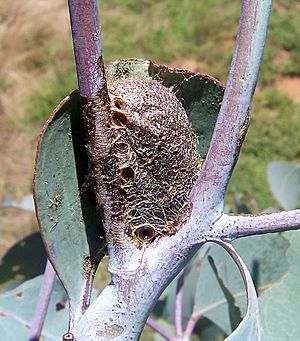
A cocoon is a protective covering made of silk that many moths and other insect larvae spin around their pupa.
Cocoons can be tough or soft, see-through or opaque, and come in many colors. They can also have multiple layers, depending on the insect. Many moth caterpillars add their own hairs to the cocoon, which can make it itchy if touched. Some larvae attach small twigs, bits of poop, or pieces of plants to the outside of their cocoon to help hide it from animals that might eat them. Others spin their cocoon in secret spots, like under a leaf, in a crack, or hidden in leaf litter.
The silk from the cocoon of the silk moth is used to make silk fabric. This makes the silk moth one of the most important insects for humans! The silk moth is the only insect that is completely domesticated, meaning it doesn't live in the wild anymore.
Insects inside a cocoon need a way to get out. They either cut their way out or release special liquids that soften the cocoon. Some cocoons even have weak spots or exit holes built in, making it easier for the adult insect to escape once it's ready.
Puparium
Some pupae stay inside the hardened skin of their last larval stage. This hard outer shell is called a puparium (say: pyoo-PAIR-ee-um). Many flies have puparia.
Images for kids
-
Fruit fly (Drosophila melanogaster) pupa
-
An Emperor gum moth caterpillar spinning its cocoon
-
American moon moth cocoon and pupa
-
Chrysalis of Gulf fritillary
-
Monarch butterfly chrysalis
-
Pupae of Japanagromyza inferna, a gall fly, inside a gall on Centrosema virginianum
-
Pupa of cabbage looper
-
A special X-ray image showing inside the chrysalis of a painted lady butterfly (Vanessa cardui)
See also
 In Spanish: Pupa para niños
In Spanish: Pupa para niños


